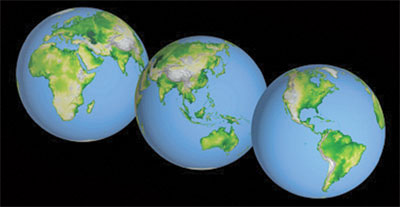Geo facts
The Continental drift
All of you must be familiar with the map of the world by now. Some of
you may be able to even say in which part of the globe a particular
country is situated because you see the map of the world so often when
you study geography at school and also watch television, read books and
newspapers.
 However,
the world map was not always like the one we know today with North
America on top of South America, Europe north of Africa, Australia off
at the bottom right and so on. However,
the world map was not always like the one we know today with North
America on top of South America, Europe north of Africa, Australia off
at the bottom right and so on.
Why was it different to what it is today? The answer to this
important question is the continental drift (the movement of the Earth's
continents relative to each other by appearing to drift across the ocean
bed) or the plate tectonics as the modern theory goes.
The theory of continental drift put forward by early scientists was
superseded by the theory of plate tectonics, which builds upon and
better explains why the continents move.The speculation that continents
might have 'drifted' was first put forward by Abraham Ortelius in 1596.
The concept was independently (and more fully) developed by Alfred
Wegener in 1912.
Some of you may be surprised to learn that the land masses we now
call continents were once clumped together before they eventually
drifted apart. Land masses move around in the water the way bath toys
move around in the bathtub.
However, the movement of the land masses are not as visible as the
bath toys because they move very slowly - usually no more than twenty
centimetres in a year. So, sometimes the land masses are all clumped
together in one part of the Earth, and other times they drift apart.
|

Tectonic plates are marked in white |
Do you know that since the dry land masses first appeared on Earth
about four billion years ago this has happened at least three times?
Just over a billion years ago, all the land clumped together in one big
land mass we call Rodinia.
At this time there were only simple sea plants on Earth, and nothing
much lived on land. Rodinia broke apart eventually, and then in the time
of the first spiders and insects the land came back together again in
another big clump we call Pannotia, about 500 million years ago, and
then moved apart again.
The most recent time that the land masses all clumped together was
about 250 million years ago, during the time of the dinosaurs. We call
this super-continent Pangaea (pan-JAY-ah). Then, about 180 million years
ago, the land masses began to drift apart again. When the first Pangaea
broke into two pieces they were called the Laurasia and Gondwana by the
scientists.
|

Land masses were clumped together before they drifted apart. |
Then Laurasia broke up into North America, Europe and Asia. Gondwana
broke up into South America, Africa, Antartica, and Australia.The land
masses are still drifting away from each other today. North America and
South America are gradually moving away from Europe and Africa, so that
the Atlantic Ocean is getting bigger and the Pacific Ocean is getting
smaller.
If you look at the continents today in the map of the world you will
notice how South America would have fitted against Africa like in a jig
saw puzzle.
What happens when land masses run into each other? Natural disasters!
When the land masses run into each other, or slide under each other, it
causes earthquakes and volcanoes, Sometimes huge mountain chains, like
the Alps or the Himalayas, get pushed up high above sea level.
The California edge of the Pacific Ocean is ramming into North
America and sliding past it, causing earthquakes in California and
forming the Rocky Mountains.
In several hundred million years, the Pacific Ocean will disappear,
and the West Coast of North America will smash into Japan and China,
forming another large land mass, and probably another large mountain
range.
[Fact file]
* The theory of continental drift was not accepted for many years.
One problem was that a plausible driving force was missing. Today
evidence for the movement of continents on tectonic plates is now
extensive. Similar plant and animal fossils are found around different
continent shores, suggesting that they were once joined.
* Plate tectonics is a scientific theory that describes the
large-scale motions of Earth’s lithosphere. The model builds on the
concepts of continental drift, developed during the first decades of the
20th century. It was accepted by the geoscientific community after the
concepts of seafloor spreading were developed in the late 1950s and
early 1960s.
* The lithosphere is broken up into tectonic plates. On Earth, there
are seven or eight major plates (depending on how they are defined) and
many minor plates.
Tectonic plates are composed of oceanic lithosphere and thicker
continental lithosphere, each topped by its own kind of crust. |



